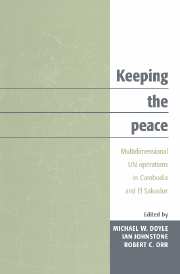Book contents
- Frontmatter
- Contents
- Preface
- Notes on the contributors
- List of abbreviations
- 1 Introduction
- Cambodia
- El Salvador
- Map
- 9 Insurrection and civil war in El Salvador
- 10 Peacemaking in El Salvador
- 11 The El Salvador Peace Accords: using international and domestic law norms to build peace
- 12 From peacekeeping to peacebuilding: restructuring military and police institutions in El Salvador
- 13 Rights and reconciliation in El Salvador
- 14 The arms-for-land deal in El Salvador
- Conclusion and chronologies
- Select bibliography
- Index
10 - Peacemaking in El Salvador
Published online by Cambridge University Press: 22 October 2009
- Frontmatter
- Contents
- Preface
- Notes on the contributors
- List of abbreviations
- 1 Introduction
- Cambodia
- El Salvador
- Map
- 9 Insurrection and civil war in El Salvador
- 10 Peacemaking in El Salvador
- 11 The El Salvador Peace Accords: using international and domestic law norms to build peace
- 12 From peacekeeping to peacebuilding: restructuring military and police institutions in El Salvador
- 13 Rights and reconciliation in El Salvador
- 14 The arms-for-land deal in El Salvador
- Conclusion and chronologies
- Select bibliography
- Index
Summary
Introduction
The Salvadoran peace process has been hailed by diplomats as a “negotiated revolution,” a “jewel in a crown of thorns.” Secretary-General Boutros Boutros-Ghali further labeled it a “definitive moment in the history of El Salvador,” as well as a “pioneering effort in peacekeeping.” Only the coming months and years will tell whether these accolades were premature or if in fact, after one hundred years of internal struggle and bloody conflict, the peace process will prove irreversible. Whatever the final outcome, the complex negotiations, which culminated in the formal cessation of hostilities on December 16, 1992, witnessed the creation of many new mechanisms that will prove essential to future UN peacekeeping, peacemaking and peacebuilding activities.
The purpose of this chapter is to review the diplomatic history of the Salvadoran peace process with the aim of revealing the many unique and unprecedented features of this process. The discussion will begin with an overview of the diplomatic efforts and negotiations during the 1980s which gradually paved the way for the peace process that began officially in Geneva on April 4, 1990. It will end with the signing of the Chapultepec Accords on January 16, 1992, after which I will highlight several of the important innovations of the United Nations role in the Salvadoran negotiations.
In contrast to the Cambodian peace process, where four years of negotiations culminated in one all-encompassing agreement, the negotiating process in El Salvador was piecemeal and more spontaneous.
- Type
- Chapter
- Information
- Keeping the PeaceMultidimensional UN Operations in Cambodia and El Salvador, pp. 227 - 254Publisher: Cambridge University PressPrint publication year: 1997
- 2
- Cited by



